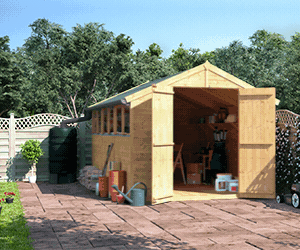Jump to:
Setting up outdoor lighting comes with some considerations and requirements. It helps to have a clear idea of what you want to achieve with your garden. This includes which features you want to highlight, where the lights should go to get the right effect, and the ideal lumens.
This guide is a great starting point.
What Does Outdoor Lighting Do for Your Space?

The purpose of outdoor lighting is to illuminate areas that would otherwise remain out of the spotlight. From there, think of which part of your backyard or front garden you want to take centre stage. Is your goal to improve the visual curb appeal of your landscape? Focus on fixtures with soft lighting that highlight your paths or plants.
Do you want to make your home feel safer? Mounting motion-sensor lights near entrances and along walkways is a smart move. Perhaps you’d like to create a cosy atmosphere for evening get-togethers outdoors. If that’s the case, string lights or lanterns in seating areas are the bright options for the job.
Would you like to show off certain features, like trees or a water fountain, to make your garden pop at night? Spotlights can work wonders, making them pop after dark.
Outdoor Lighting Requirements for Different Zones or Areas
Every area in your outdoor space has its own lighting needs, including lumens. Lumens tell you how bright a light will be. Understanding them helps you pick the right brightness for each zone. Here’s a quick overview of what to consider, along with some handy tips and ideas:
Pathways and walkways
The lights need to be bright enough so people can see where they’re going, usually about 100 lumens for each. Ground lights should be spaced about 6 to 8 feet apart.
Entrances and exits
Entry points should be well-lit for safety and security. We recommend using motion-sensor lights or fixtures that provide at least 200 lumens.
You may want to have a look at the Biard Gettsdorf LED Adjustable Up/Down Wall Light. It features an up/down lighting design with two adjustable stems. This allows you to direct light wherever you need it, such as on pathways. This particular model also uses energy-efficient LED lights, saving ou money in the long run.
Decks and patios
Soft lighting is great for creating a cosy atmosphere. These lantern string lights fit the bill; even better, they’re solar-powered! Look for fixtures that emit 50 to 100 lumens.
Garden areas
Accent outdoor lighting brings those garden features to life, whether it’s your favourite plants or sculpture. You’ll want to aim for about 50 to 150 lumens for each light. Solar powered garden lights are a great choice here.
Uplights, for one, can give you that dramatic effect, while spotlights, such as this spike garden light, offer a more subtle touch. Either way, both are brilliant for adding depth and interest to your garden. For pools and water features, choose waterproof and energy-efficient lights with around 100 lumens.
Security lighting
For this purpose of outdoor lighting, around 200 to 800 lumens are ideal. Floodlights, like the Biard LED Outdoor Floodlight with PIR Motion Sensor, supply broad, intense illumination.
Position your security lights to cover all vulnerable spots, like corners and windows. The fixtures must be placed at eye level or just above so the light casts directly where you need it.
Round-up
If you know what you want your outdoor lighting to do for your space, it makes the planning so much easier. Whether you’re after a relaxed setting for evenings or want to make sure everyone can see where they’re going.
So, pick lights with the lumen and set them up in the right spot, and it’ll make your outdoor area feel just right! For more options, have a look at our range of outdoor lighting, including driveway lights.
Up next on your reading list: What Is the Best IP Rating for Outdoor Lighting?













What do you think ?